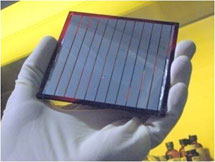
Handy Links
SLAC News Center
SLAC Today
- Subscribe
- Archives: Feb 2006-May 20, 2011
- Archives: May 23, 2011 and later
- Submit Feedback or Story Ideas
- About SLAC Today
SLAC News
Lab News
- Interactions
- Lightsources.org
- ILC NewsLine
- Int'l Science Grid This Week
- Fermilab Today
- Berkeley Lab News
- @brookhaven TODAY
- DOE Pulse
- CERN Courier
- DESY inForm
- US / LHC
SLAC Links
- Emergency
- Safety
- Policy Repository
- Site Entry Form

- Site Maps
- M & O Review
- Computing Status & Calendar
- SLAC Colloquium
- SLACspeak
- SLACspace
- SLAC Logo
- Café Menu
- Flea Market
- Web E-mail
- Marguerite Shuttle
- Discount Commuter Passes
-
Award Reporting Form
- SPIRES
- SciDoc
- Activity Groups
- Library
Stanford
Around the Bay
Understanding Active Materials in Organic Solar Cells

Organic or plastic solar cells have achieved efficiencies greater than 8 percent in converting sunlight to usable electric energy. That's close to the estimated 10-15 percent needed to make them economically viable. To close the gap, researchers need to improve control of the nanostructure of the active, energy-converting layer in these organic solar cells.
Recently, scientists from the University of California Santa Barbara and the Stanford Synchrotron Radiation Lightsource studied a common active layer for organic solar cells. The material contains a polymer, P3HT, with a partially ordered or "crystalline" structure, and a hollow carbon-based molecule, or "fullerene," called PCBM.
To better understand the ability of the two components to mix during the manufacturing process, the researchers studied the structure of the active layer through combined depth profiling measurements at UC Santa Barbara and X-ray diffraction at SSRL Beamline 11-3. These methods allowed them to determine that PCBM is mobile in non-ordered regions of the P3HT polymer, and moves without disrupting the P3HT crystalline structure. This mixing of PCBM in the P3HT polymer was observed at relatively low temperatures and was rapid at temperatures typically used in solar cell manufacturing (e.g., 150°C).
These studies suggest that in P3HT–PCBM organic solar cells there is a tendency to form a three-part mixture of pure P3HT crystallites, pure PCBM, and a mixture of disordered P3HT and PCBM. This observation of the mixing behavior enables a more complete understanding and better basis for modeling these sunlight-conversion devices, which can potentially lead to improved solar cells.
This work was published in the January 1, 2011, issue of Advanced Energy Materials. To learn more, see the full scientific highlight.
—Kelen Tuttle, SSRL Headlines
SLAC Today, April 4, 2011